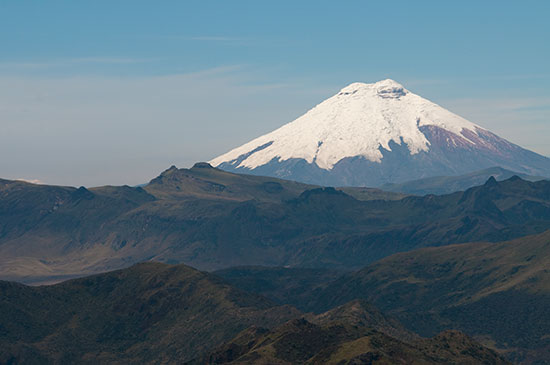| This article is incomplete. This article is missing one or more sections. You can help the BirdForum Opus by expanding it. |
Overview
Lat: 0 48” S Lon: 78 26” W
Cotopaxi National Park is about 30 km south of the city of Quito. It is named after the Cotopaxi, which is considered the highest active volcano in the world at 5,864 meters (19,350 ft.). This is the most visited park in Ecuador, but with 33,393 ha. (83,000 acres) of land there is plenty of room to find quiet areas to go birding.
Temperature average 7 degrees C (45 F). Cotopaxi is covered with clouds most of the year but the months of June – September can provide a good deal of sunshine. Deforestation has destroyed most of the native trees but pines and paramo grasses harbor a great variety of birds. Lake Limpiopungo provides a habitat for many species of waterfowl as well as the marsh grasses that are home to the Noble Snipe. A walk around the lake can reveal 10 to 15 different species birds.
Exploring the park one can encounter many species of raptors including the Carunculated Caracara, Black-chested Buzzard-Eagle, and Variable Hawk.
Birds
Notable Species
Andean Condor, Giant Conebill, Noble Snipe, Andean Gull, Andean Coot
Rarities
Andean Condor, Plain-breasted Hawk, Fulica ardesiaca, Spotted Sandpiper, Solitary Sandpiper, Upland Sandpiper, Sparkling Violetear, Purple-backed Thornbill, Mountain Avocetbill, Bar-bellied Woodpecker, White-browed Spinetail, Rufous Antpitta, Ocellated Tapaculo, Spillmann's Tapaculo, White-banded Tyrannulet, White-throated Tyrannulet, Agile Tit-Tyrant, Paramo Ground-Tyrant, Muscisaxicola alpinus, Chestnut-bellied Cotinga, Barred Becard, Rufous Wren, Superciliaried Hemispingus, Oleaginous Hemispingus, Plushcap, Black-backed Bush Tanager, Hooded Mountain-Tanager, Black-chested Mountain-Tanager, Masked Mountain-Tanager, Paramo Seedeater, Masked Flowerpiercer, Stripe-headed Brush-Finch
Check-list
Birds you can see here include:
Curve-billed Tinamou, Andean Teal, Yellow-billed Pintail, Blue-winged Teal, Cinereous Harrier, Black-chested Buzzard-Eagle, Variable Hawk, Carunculated Caracara, American Kestrel, Aplomado Falcon, Ecuadorian Rail, Andean Coot, Greater Yellowlegs, Lesser Yellowlegs, Semipalmated Sandpiper, Least Sandpiper, Baird's Sandpiper, Pectoral Sandpiper, Stilt Sandpiper, Noble Snipe, Andean Snipe, Wilson's Phalarope, Rufous-bellied Seedsnipe, Andean Lapwing, Grey Plover, American Golden-Plover, Andean Gull, Eared Dove, Black-winged Ground-Dove, Great Horned Owl, Burrowing Owl, Band-winged Nightjar, White-collared Swift, Sparkling Violet-ear, Ecuadorian Hillstar, Giant Hummingbird, Shining Sunbeam, Great Sapphirewing, Black-tailed Trainbearer, Tyrian Metaltail, Rainbow-bearded Thornbill, Blue-mantled Thornbill, Bar-winged Cinclodes, Stout-billed Cinclodes, Andean Tit-Spinetail, Azara's Spinetail, White-chinned Thistletail, Streak-backed Canastero, Many-striped Canastero, Tawny Antpitta, Unicolored Tapaculo, Tufted Tit-Tyrant, Brown-backed Chat-Tyrant, Streak-throated Bush-Tyrant, Black-billed Shrike-Tyrant, Paramo Ground-Tyrant, White-browed Ground-Tyrant, Spot-billed Ground-Tyrant, Great Thrush, Brown-bellied Swallow, Blue-and-white Swallow, Barn Swallow, Grass Wren, Mountain Wren, Paramo Pipit, Black-crested Warbler, Cinereous Conebill, Black Flowerpiercer, Blue-and-yellow Tanager, Golden-bellied Grosbeak, Black-backed Grosbeak, Plain-colored Seedeater, Paramo Seedeater, Band-tailed Seedeater, Plumbeous Sierra-Finch, Band-tailed Sierra-Finch, Grassland Yellow-Finch, Rufous-naped Brush-Finch, Rufous-collared Sparrow, Hooded Siskin
Other Wildlife
Puma, Spectacled Bear, Andean Wolf, Deer, Marsupial Mice, Llamas and Wild Horses
Site Information
History and Use
To do
Areas of Interest
To do
Access and Facilities
There are two different entrances to Cotopaxi National Park. The northern entrance can be reached by turning left and going through the town of Machachi. The road is made of stone and is not well maintained in places. It travels through farmland and there are several species of birds that can be seen along the route.
The main entrance is on the western side of the mountain. This is easily accessible by traveling south on the PanAmerican Highway. After you pass the toll booth ($1 for cars) you will go up side of the mountain. When you travel down the other side look for the signs for Cotopaxi National Park on the left. You will cross a railroad track and then travel about 10km to the main entrance. The cost is $10 for foreigners and $2 for locals. Continue on this road into the park, about another 5km.
Once in the park you will see Lake Limpiopungo on the left. There is a large parking area and well maintained paths that circumvent the lake. Many species of birds can be encountered at this point. From here you can continue further into the park on gravel roads. In some areas the roads are well maintained but others can be a little rough.
There are several Inca ruins in the park. (You will receive a map when you enter the park that indicates the locations of these ruins.) There are also wild horses roaming the area. Camping is permitted in the park and it is possible to go horseback riding, bicycling, hiking, and mountain climbing.
There is a Hosteria (Tambopaxi Hotel) located within the park that offers rooms and a restaurant. There are also public bathrooms available for anyone passing through.
Contact Details
To do
External Links
To do




